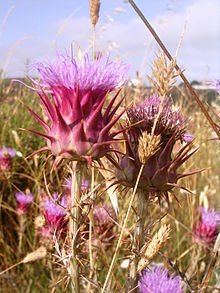Cardoon

The cardoon, Cynara cardunculus, also called the artichoke thistle, is a thistle in the sunflower family. It is a naturally occurring species that also has many cultivated forms, including the globe artichoke. It is native to the western and central Mediterranean region, where it was domesticated in ancient times and still occurs as a wild plant.
The wild cardoon is a stout herbaceous perennial plant growing 0.8 to 1.5 m (31 to 59 in) tall, with deeply lobed and heavily spined green to grey-green tomentose (hairy or downy) leaves up to 50 cm (20 in) long, with yellow spines up to 3.5 cm long. The flowers are violet-purple, produced in a large, globose, massively spined capitulum up to 6 cm (2 in) in diameter.[2][3][4][5]
It is adapted to dry climates, native across a circum-Mediterranea area from Morocco and Portugal east to Libya and Greece and north to Croatia and Southern France;[6] it may also be native on Cyprus, the Canary Islands and Madeira.[7] In France, it only occurs wild in the Mediterranean south (Gard, Hérault, Aude, Pyrénées-Orientales, Corsica).[4] It has become an invasive weed in the pampas of Argentina,[5] and is also considered a weed in Australia and California.[8][9][10][11]
